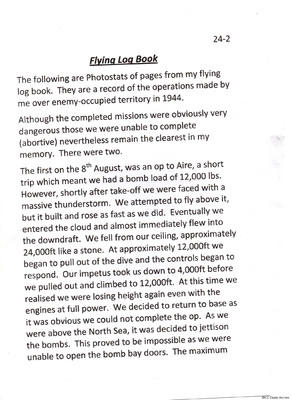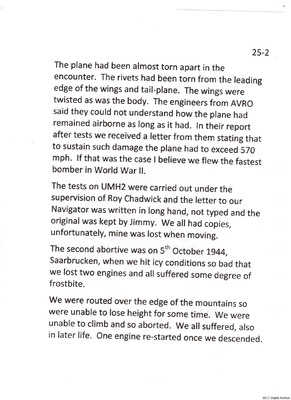Pages from memoir
Title
Pages from memoir
Description
First page titled 'Flying log book' mentions photostats from log book which were record of operations over enemy-occupied territory in 1944. Describes one operation to Aire during which they had to return to base due to violent weather. Continues with return to Wickenby and description of damage to aircraft and fact that to achieve this damage the aircraft would have had to exceed 570 mph. Concludes with mention another abortive attempt.
Temporal Coverage
Language
Type
Format
Three page printed document
Publisher
Rights
This content is available under a CC BY-NC 4.0 International license (Creative Commons Attribution-NonCommercial 4.0). It has been published ‘as is’ and may contain inaccuracies or culturally inappropriate references that do not necessarily reflect the official policy or position of the University of Lincoln or the International Bomber Command Centre. For more information, visit https://creativecommons.org/licenses/by-nc/4.0/ and https://ibccdigitalarchive.lincoln.ac.uk/omeka/legal.
Contributor
Identifier
BPotterPLPotterPLv9
Transcription
[underlined]Flying Log Book[/underlined]
The following are Photostats of pages from my flying log book. They are a record of the operations made by me over enemy-occupied territory in 1944.
Although the completed missions were obviously very dangerous those we were unable to complete (abortive) nevertheless remain the clearest in my memory. There were two.
The first on the 8th August, was an op to Aire, a short trip which meant we had a bomb load of 12,000 Ibs. However, shortly after take-off we were faced with a massive thunderstorm. We attempted to fly above it, but it built and rose as fast as we did. Eventually we entered the cloud and almost immediately flew into the downdraft. We fell from our ceiling, approximately 24,000ft like a stone. At approximately 12,000ft we began to pull out of the dive and the controls began to respond. Our impetus took us down to 4,000ft before we pulled out and climbed to 12,OOOft. At this time we
realised we were losing height again even with the engines at full power. We decided to return to base as it was obvious, we could not complete the op. As we were above the North Sea, it was decided to jettison the bombs. This proved to be impossible as we were unable to open the bomb bay doors. The maximum
[page break]
speed we could maintain was about 140 mph and we were gradually losing height. We found out later that both the outboard engines had torn away from their side mountings and they were pointing down about 15 degrees, pulling us down even though we were at full power.
We reached Wickenby with a few hundred feet to spare and made a perfect landing. We had to. We could not have gained height again for another attempt. As we touched down on the runway the photo flash, equivalent to a SOOlb bomb, fell out and came bouncing down the runway behind us, sparks flying everywhere. Luckily it didn't explode. We were directed to the most remote area of the airfield and
evacuated the aircraft in record time.
During the descent in the cloud, we were entertained by a most brilliant display of St. Elmo's Fire. The whole aircraft was covered with balls of fire running about. We took photographs but none showed the fire. However, parts of the plane showed as clear as if the photographs had been taken in sunlight.
[page break]
The plane had been almost torn apart in the encounter. The rivets had been torn from the leading edge of the wings and tail-plane. The wings were twisted as was the body. The engineers from AVRO said they could not understand how the plane had
remained airborne as long as it had. In their report after tests we received a letter from them stating that to sustain such damage the plane had to exceed 570 mph. If that was the case, I believe we flew the fastest bomber in World War 11.
The tests on UMH2 were carried out under the supervision of Roy Chadwick and the letter to our Navigator was written in long hand, not typed and the original was kept by Jimmy. We all had copies, unfortunately, mine was lost when moving.
The second abortive was on 5th October 1944, Saarbrucken, when we hit icy conditions so bad that we lost two engines and all suffered some degree of
frostbite.
We were routed over the edge of the mountains so were unable to lose height for some time. We were unable to climb and so aborted. We all suffered, also in later life. One engine re-started once we descended.
The following are Photostats of pages from my flying log book. They are a record of the operations made by me over enemy-occupied territory in 1944.
Although the completed missions were obviously very dangerous those we were unable to complete (abortive) nevertheless remain the clearest in my memory. There were two.
The first on the 8th August, was an op to Aire, a short trip which meant we had a bomb load of 12,000 Ibs. However, shortly after take-off we were faced with a massive thunderstorm. We attempted to fly above it, but it built and rose as fast as we did. Eventually we entered the cloud and almost immediately flew into the downdraft. We fell from our ceiling, approximately 24,000ft like a stone. At approximately 12,000ft we began to pull out of the dive and the controls began to respond. Our impetus took us down to 4,000ft before we pulled out and climbed to 12,OOOft. At this time we
realised we were losing height again even with the engines at full power. We decided to return to base as it was obvious, we could not complete the op. As we were above the North Sea, it was decided to jettison the bombs. This proved to be impossible as we were unable to open the bomb bay doors. The maximum
[page break]
speed we could maintain was about 140 mph and we were gradually losing height. We found out later that both the outboard engines had torn away from their side mountings and they were pointing down about 15 degrees, pulling us down even though we were at full power.
We reached Wickenby with a few hundred feet to spare and made a perfect landing. We had to. We could not have gained height again for another attempt. As we touched down on the runway the photo flash, equivalent to a SOOlb bomb, fell out and came bouncing down the runway behind us, sparks flying everywhere. Luckily it didn't explode. We were directed to the most remote area of the airfield and
evacuated the aircraft in record time.
During the descent in the cloud, we were entertained by a most brilliant display of St. Elmo's Fire. The whole aircraft was covered with balls of fire running about. We took photographs but none showed the fire. However, parts of the plane showed as clear as if the photographs had been taken in sunlight.
[page break]
The plane had been almost torn apart in the encounter. The rivets had been torn from the leading edge of the wings and tail-plane. The wings were twisted as was the body. The engineers from AVRO said they could not understand how the plane had
remained airborne as long as it had. In their report after tests we received a letter from them stating that to sustain such damage the plane had to exceed 570 mph. If that was the case, I believe we flew the fastest bomber in World War 11.
The tests on UMH2 were carried out under the supervision of Roy Chadwick and the letter to our Navigator was written in long hand, not typed and the original was kept by Jimmy. We all had copies, unfortunately, mine was lost when moving.
The second abortive was on 5th October 1944, Saarbrucken, when we hit icy conditions so bad that we lost two engines and all suffered some degree of
frostbite.
We were routed over the edge of the mountains so were unable to lose height for some time. We were unable to climb and so aborted. We all suffered, also in later life. One engine re-started once we descended.
Collection
Citation
“Pages from memoir,” IBCC Digital Archive, accessed July 4, 2024, https://ibccdigitalarchive.lincoln.ac.uk/omeka/collections/document/30875.
Item Relations
This item has no relations.



